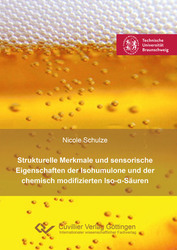| Areas | |
|---|---|
| Serie de libros (96) |
1378
|
| Nachhaltigkeit |
3
|
| Gesundheitswesen |
1
|
| Letra |
2364
|
| Ciencias Naturales |
5406
|
| Matemática | 229 |
| Informática | 319 |
| Física | 980 |
| Química | 1363 |
| Geociencias | 131 |
| Medicina humana | 243 |
| Estomatología | 10 |
| Veterinaria | 108 |
| Farmacia | 147 |
| Biología | 835 |
| Bioquímica, biología molecular, tecnología genética | 121 |
| Biofísica | 25 |
| Nutrición | 45 |
| Agricultura | 1004 |
| Silvicultura | 201 |
| Horticultura | 20 |
| Ecología y conservación de la tierra | 148 |
| Ciencias Ingeniería |
1793
|
| General |
98
|
|
Leitlinien Unfallchirurgie
5. Auflage bestellen |
|
Erweiterte Suche
Strukturelle Merkmale und sensorische Eigenschaften der Isohumulone und der chemisch modifizierten Iso-α-Säuren (Tienda española)
Nicole Schulze (Autor)Previo
Lectura de prueba, PDF (480 KB)
Indice, PDF (87 KB)
Das Thema dieser Arbeit war die analytische und sensorische Charakterisierung der Isomere und Homologen der Iso-α-Säuren, der Tetrahydroiso-α-Säuren, der Hexa¬hydroiso-α-Säuren und der Dihydroiso-α-Säuren (Rhoiso-α-Säuren). Die einzelnen Isomere und Homologe wurden mittels präparativer HPLC isoliert und deren strukturelle Merkmale mittels NMR charakterisiert. Für die sensorische Charakterisierung wurden die Reiz- und Erkennungsschwellenwerte und der zeitliche Verlauf der Bitterintensität bestimmt. Weiterhin wurde eine Methode der deskriptiven Analyse (Profilierung) unter Verwendung der Deskriptoren “bitter”, “adstringierend”, “medizinisch”, “phenolisch”, “metallisch” und “krautig” entwickelt und die sensorisch stimulierten Regionen im Mund- und Rachenraum bestimmt. Die Einflussnahme der cis/trans-Isomerie, der (1’’R)/(1 ’’S)-Isomerie und der verschiedenen Acyl-Seiten¬ketten auf die sensorische Wahrnehmung und Eigenschaften wurde untersucht und mit den sensorischen Merkmalen der Bitterstoffe Koffein, Amarogentin, Naringin, Chininhydrochlorid, Salicin, Epigallocatechingallat (EGCG) und den Hopfenbitter¬produkten Isohop®, Hexahop® 95, Tetrahop® und Redihop® verglichen.
The topic of this thesis was the sensorial and analytical investigation of the isomers and homologs of the Iso-α-acids, the Tetrahydroiso-α-acids, the Hexahydroiso-α-acids and the Dihydroiso-α-acids (Rhoiso-α-acids). The isomers and homologs were isolated by preparative HPLC and characterized by NMR. The threshold values and the bitter-time-intensity were determined for the sensorial characterization of the isolated isomers and homologs. Furthermore a method of descriptive analysis was developed using the descriptors “bitter”, “astringent”, “medicinal”, “phenolic”, “metallic” and “herbaceous” and to determine the stimulated areas in mouth and pharynx. The influence of the cis/trans isomerism, the (1‘‘R)/(1‘‘S) isomerism and the different acyl side chains on the sensorial perception and on the sensorial properties was investigated and compared with the bitter compounds Caffeine, Amarogentin, Naringin, Chininhydrochloride, Salicine, Epigallocatechin Gallate (EGCG) and with the hop bitter products Isohop®, Hexahop® 95, Tetrahop® und Redihop®.
| ISBN-13 (Impresion) | 9783736995352 |
| ISBN-13 (E-Book) | 9783736985353 |
| Formato | A5 |
| Idioma | Alemán |
| Numero de paginas | 300 |
| Edicion | 1. Aufl. |
| Lugar de publicacion | Göttingen |
| Lugar de la disertacion | Braunschweig |
| Fecha de publicacion | 10.05.2017 |
| Clasificacion simple | Tesis doctoral |
| Area |
Química analítica
Química de alimentación |
| Palabras claves | Iso-α-Säuren, Isohumulone, Tetrahydroiso-α-Säuren, Rhoiso-α-Säuren, Isohop, Tetrahop, Hexahop, Redihop, Isomere, NMR, Schwellenwerte, Bitter-Time-Intensity, Profilierung, Amarogentin, Koffein, Chininhydrochlorid, EGCG, Naringin, Sensorik |








